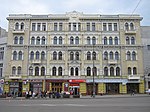Annunciation Cathedral, Kharkiv

The Annunciation Cathedral (Ukrainian: Свято-Благовіщенський кафедральний собор; Russian: Благовещенский собор) is the main Orthodox church of Kharkiv, Ukraine. The pentacupolar Neo-Byzantine structure with a distinctive 80-meter-tall bell tower was completed on 2 October 1888, from designs by a local architect, Mikhail Lovtsov. The church was consecrated in 1901, and the earlier Annunciation church was then pulled down. The candy-striped cathedral supplanted the older Assumption Cathedral as the main church of Kharkiv and was one of the largest and tallest churches of the Russian Empire. The icon screen used to be of Carrara marble. The church was frescoed in a style derived from St Vladimir's Cathedral in Kyiv. On 3 July 1914 the church became recognized as the city's cathedral. The cathedral was closed to worshippers in 1930, but it was reopened during the German occupation in 1943. The church was then in the hands of the Ukrainian Autocephalous Orthodox Church and harbored a school, though claims abound that it was later used as a warehouse. Since 1946 the cathedral has been the seat of the Kharkiv and Bohodukhiv eparchy of the Ukrainian Orthodox Church (Moscow Patriarchate), while the Intercession Convent has served as the bishop's residence. The Ecumenical Patriarch Athanasius III and several saintly bishops are buried in the cathedral.
Excerpt from the Wikipedia article Annunciation Cathedral, Kharkiv (License: CC BY-SA 3.0, Authors, Images).Annunciation Cathedral, Kharkiv
Blahovishchenska Square, Kharkiv Залопань
Geographical coordinates (GPS) Address Nearby Places Show on map
Geographical coordinates (GPS)
| Latitude | Longitude |
|---|---|
| N 49.990277777778 ° | E 36.224166666667 ° |
Address
Благовіщенська площа
Blahovishchenska Square
61011 Kharkiv, Залопань
Kharkiv Oblast, Ukraine
Open on Google Maps











